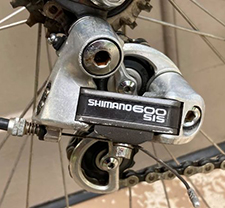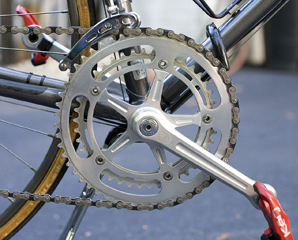 I am often asked, “What was the standard component package on the Fuso?” or John Howard, or Recherché.
I am often asked, “What was the standard component package on the Fuso?” or John Howard, or Recherché.
The answer: There was no standard component package. The reason, I only sold frames, not complete bikes. The frames were ordered by bicycle dealers, usually for a specific customer, who then chose the components and the bike shop ordered these in and built the bike.
Often what happened was the customer could not afford an all Campagnolo or Shimano Dura-Ace equipped bike. So the dealer built the bike with lower priced components like Sugino, Sun Tour, or Shimano 600.
The thinking was, (And I agreed.) the frame is what determines how the bike fits, handles, and feels to the rider. Wheels are the next important factor, but after that a Sugino crankset, or cheaper pedals will, for the most part, feel no different than Campagnolo. The main difference is the quality of finish and the durability of the product, not so much in the ride quality.
The theory was, get a newcomer on a quality frame, get them hooked on cycling and they would come back and upgrade to a better quality component later. This was a smart business move for the Bike Dealer, and it sold frames for me.
For about the same price as say a mid range Japanese or European import, a customer could get on one of my frames with lower priced components. And of course when the customer compared the mid range import and my bike on a test ride they could feel the difference.
That was the theory. In reality what happened in many cases, the bike purchase was an impulse thing, and after a short period, the bike ended up sitting in the garage where many still languish to this day.
 From time to time such a bike comes up on eBay, often with a mish-mosh of cheap components. If you are buying such a bike, realize that you are basically buying it for the frame. If you strip the components to replace them with, say Campagnolo; these left over parts will have little or no resale value.
From time to time such a bike comes up on eBay, often with a mish-mosh of cheap components. If you are buying such a bike, realize that you are basically buying it for the frame. If you strip the components to replace them with, say Campagnolo; these left over parts will have little or no resale value.
On the other hand, many may not want such a bike. If you can buy it at a bargain price, you can ride as originally intended and upgrade the components as they become available.
 Mon, August 9, 2021
Mon, August 9, 2021  From time to time such a bike comes up on eBay, often with a mish-mosh of cheap components.
From time to time such a bike comes up on eBay, often with a mish-mosh of cheap components. 



























Ebay Prices and my Bike Registry
It has been over ten years since I opened my “Bike Registry” in August 2010. My blog had started five years earlier in 2005 and a result I was getting emails from owners of bikes I had built. I realized in order to preserve these bikes there needed to be information online, so someone finding one would realize the bike had value, and there were people interested in owning one.
The Registry has worked because there is hardly a week goes by, that I don’t get two or three emails from people who have inherited a Fuso, or another bike I built, or they found one in a yard-sale, and they want to know how much it is worth.
I can tell you over the last ten years that my Registry has existed, the price has held steady, on average around $500 or $600. A really nice one in mint condition with top-of-the-line components will occasionally go for $1,000, or even more. But there has to be someone willing to pay that much for a bike that is the size that the buyer needs.
On eBay at the time I am writing this there are five bikes with frames I built, priced between $695 and $2,400, plus $100 to $150 for shipping. The bike that is priced at $2,400 (Pictured above.) has been on eBay for at least three years. It may be worth that much to someone, it is in mint condition, and anyone would be hard pressed to fine a nicer one. Obviously, the owner is holding out for the right buyer.
I always assume that when someone asks me for a value of a bike or frame, they expect to sell in in a reasonable amount of time. Let me tell you a true story.
About a year ago, someone emailed me to tell me they had bought a Fuso at a yard sale for $19 and asked me what it was worth. I told him $500, thinking that this was a nice little return on his investment. Within minutes of sending the email the bike appeared on eBay at a $1,000 “Buy it now” price.
I was a little annoyed, I thought, ‘Why waste my time asking for a valuation.’ Then just to rub it in, the bike sold for $1,000 by the end of that first day, and the seller emailed me to say I had given him bad information.
This is not the end of the story. A little over a week later the person who bought the bike emailed me, excited about his purchase, and wanted to add it to the registry. He sent pictures and asked me how to fix the rusted out top tube guides. Now I felt bad for him, I could not bring myself to tell he had paid way too much for the bike.
I hate to see people get screwed, whether they are buyers or sellers. Had this seller, sold the bike for $500, I would have been happy for his good fortune, and I would not have felt so bad that the buyer had paid $1,000 for what amounts to a piece of rusted out junk.
I do not influence or set prices, and neither does the presence of my Registry. Prices of vintage bikes went down in the crash of 2008, and have yet to go back to what they were prior to that. I remember a year or so before 2008 one of my custom ‘dave moulton’ bikes went for $3,000. I have not seen anything that high since.
If all you can find is a rough one in your size, you can at least ride it until a nicer one comes along, and if you did not overpay for your first bike or frame, you can sell it for what you paid for it. Do not buy vintage frames as an investment. Entered into wisely it can be a rewarding hobby that will bring hours of pleasure and healthy outdoor exercise.
Many bikes that come up for sale have been in storage for years in a garage or storage unit, the owner will ask top dollar for it, but the bike has twenty years of dirt and grime on it. Or they cannot even make an effort to drag the bike outside to take some decent pictures, they post photos of the bike still amongst the clutter it was discovered.
Wash the bike with soap and water as you would a car, do not wipe the dirt off with a dry rag or you will scratch the paint. Chances are if the bike has spent most of its life in storage it will clean up like new and will be worth more.
On the other hand, if the bike has been stored in a barn or shed without climate control, or worse still, outside under a tarpaulin, chances are the aluminum components will be badly corroded, and the frame rusted. The bike still has some value but far less than one in nice condition. However, you may get a hundred dollars or more for it, and someone may get pleasure in restoring it. Rather that than send it to the dump.
If you have one to sell it is your prerogative to ask as much as you feel you can get. You can always come down in price. One suggestion, you start the bidding at $500 or lower and place a reserve on it at $1,000 or whatever you think it is worth and see how high the bidding will go.
If you are a buyer, the prices you see on eBay are what the sellers are asking, not necessarily what the bike is worth, it is worth what you are willing to pay. Join the Dave Moulton Bikes Facebook group it is a good place to find bikes for sale by other DMB enthusiasts who know the true value of bikes I built is not in a dollar amount but the way it feels to ride one.
Here is another article with tips on buying a used bike, and a PDF file you can download and print, on “Packing a bike for shipping.”